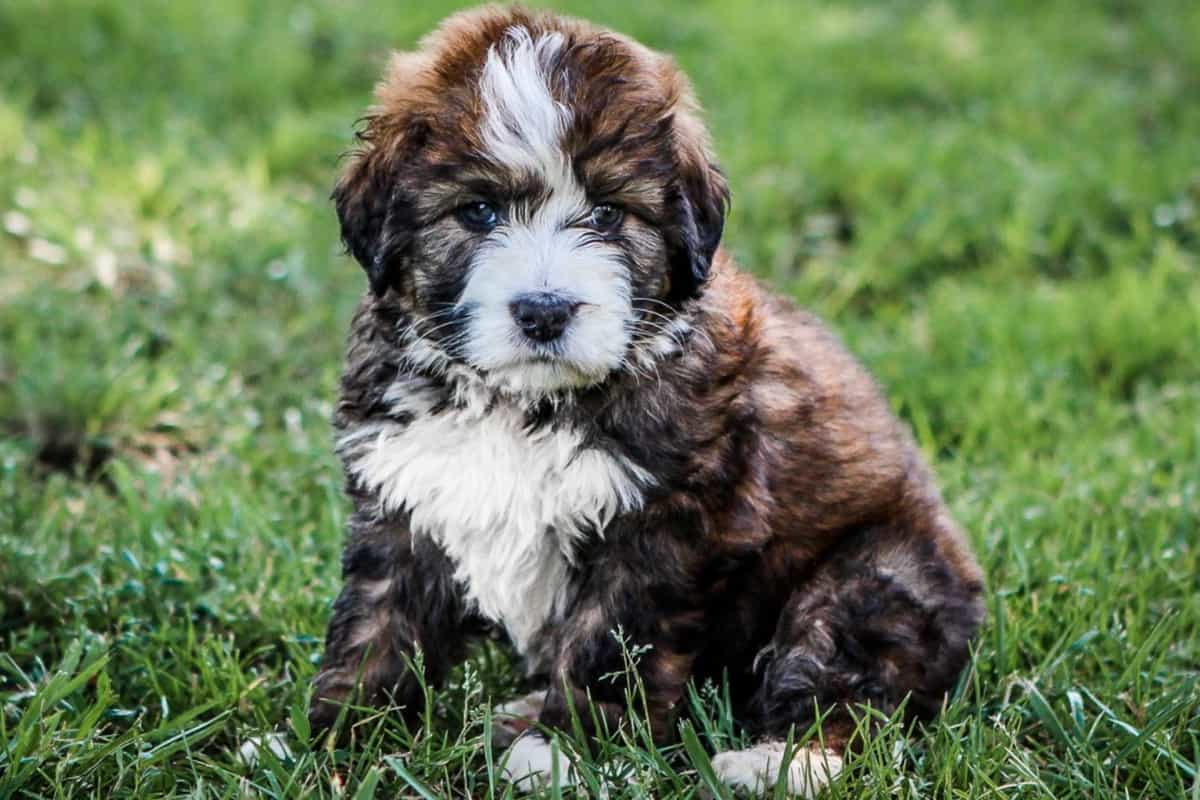Doodles have become some of the most beloved dog breeds across the globe. They are known to be wonderful family pets, highly intelligent, and full of energy. We recognize Goldendoodles and Labradoodles for their teddy bear appearance and hypoallergenic coat.
Recently, a new type of dog has evolved from these doodles, it’s called a Double Doodle. Have you ever heard of a Double Doodle? If you haven’t, chances are you’re asking the question: what is a Double Doodle?
What is a Double Doodle?
A Double Doodle is not a breed on its own. Moreso, it is a term used to describe a mixture of dog breeds. A Double Doodle is a hybrid of hybrids.
A doodle is a hybrid between two dogs, a Poodle mixed with another breed of dog. For example, a Poodle can be mixed with a Golden Retriever (Goldendoodle), a Labrador Retriever (Labradoodle), or an Australian Shepard (Aussiedoodle).
A Double Doodle occurs when hybrid breeds (doodles) are mixed. The most common Double Doodle is a Golden Doodle + Labradoodle mix, but recently, breeders have begun mixing other doodle varieties.
Most often, there are more genes from a Poodle in a Double Doodle than any other dog breed. For example, a Labradoodle (50% labrador and 50% poodle) mixed with a Goldendoodle (50% golden retriever and 50% poodle) results in a Golden Labradoodle, Which is 25% Labrador, 25% Golden Retriever, and 50% Poodle.
Double Doodles are also designer dog breeds, like regular doodles. A Designer dog is a hybrid of two different dog varieties or breeds with the goal for the offspring to only inherit the best qualities of the two parents.
Now you know what a Double Doodle is!
Common Double Doodle Varieties
The Golden Labradoodle
A Labradoodle mixed with a Goldendoodle, called a Golden Labradoodle, is the most popular Double Doodle that exists.
Both parent breeds are known for their friendly temperament and overall cute looks, so it’s no surprise that this is the most favored Double Doodle. The Golden Labradoodle also inherits its low-shedding and hypoallergenic coat from the Poodle.
The Golden Mountain Doodle
A Goldendoodle mixed with a Bernedoodle (Bernese Mountain Dog + Poodle mix) is starting to trend, mostly due to the tri-color coat of black, brown, and white derived from the Bernese Mountain Dog.
This variety of Double Doodle is also said to be less energetic than the Goldendoodles, so if you prefer a more laid-back dog with a hypoallergenic coat, then the Golden Mountain Doodle might be the choice for you.
The Double Labradoodle
A Labradoodle mixed with any other doodle, not necessarily a Golden Doodle, is known as a Double Labradoodle.
The Aussie Goldendoodle
An Aussiedoodle mixed with a Goldendoodle gives us the Aussie Goldendoodle.
These Double Doodles are growing in popularity due to the beautiful merle coat that can be inherited from the Australian Shepherd.
One of the biggest complaints about the Australian shepherd is its double coat which sheds quite a lot. Mixing an Aussiedoodle (50% Australian Shepherd and 50% poodle) with a Goldendoodle (50% golden retriever and 50% poodle) reduces the amount of shedding.
In theory, an Aussie Goldendoodle should only shed roughly 25% as much as an Australian Shepherd, since it only has 25% of Australian Shepherd genes.

Various Double Doodle Sizes
There are three main sizes of the Double Doodle: mini, medium, and standard.
The standard Double Doodle can weigh between 50-80 pounds and is considered a large-sized dog. They have a low-shedding coat so they only require weekly brushing. These large dogs would need a backyard and a fairly active pet owner.
The medium Double Doodle can weigh between 30-70 pounds. These dogs are the perfect size to run and do activities outdoors. You could even take your medium Double Doodle on your hikes.
The Mini Double Doodle has no breed standard size. Breeders often differ in what they label as mini. A mini Double Doodle usually weighs less than 30 pounds and closely represents a teddy bear. They are bred specifically for this toy-like feature.
Mini doodles are perfect for a small living space, although they do still require daily exercise, just not as much as the standard-sized Double Doodle.
History and Origin of the Double Doodle
No one is exactly sure when the first Double Doodle was bred, but it is reported that they were bred as early as the 1970s. People have always tried to combine the friendly personality of retriever dogs with the hypoallergenic coat of standard poodles.
The most common Double Doodle mix is by far the golden Labradoodle, combining a Goldendoodle with a Labradoodle.
In 1988 the first known Labradoodle was bred by an Australian breeder specifically as a guide dog with a hypoallergenic coat. Goldendoodles, however, were first bred in 1969 but rose to popularity in the 90s after Labradoodles became so well known.
Double Doodles come from a long line of gentle, loving, and easygoing dogs.
Double Doodle Health Issues
Double Doodles generally have healthy lives, and they mostly do not suffer from as many health issues as their parent breeds.
Golden retrievers have been inbred so many times that there are health issues that are relevant among the whole breed. Since Double Doodles have such a wide range of hybrid breeds, this has not yet happened to Double Doodles.
Hip dysplasia, elbow dysplasia, ear infections, retinal atrophy, cataracts, and joint issues are all common among Double Doodles and as they get older these genetic issues are more relevant.
A healthy Double Doodle can expect to live 12-15 years.
Double Doodle Coats
This is where it gets tricky as it is possible that a Double Doodle could have a double coat which means they have a top coat and an undercoat. A double coat also means a lot more shedding.
Fortunately, double-coated doodles are rare. Most doodles have a low-shedding, hypoallergenic coat thanks to poodles.
Double Doodle coats also come in three main types:
- Straight
- Wavy
- Curly
In addition to the different coat types, Double Doodles also come in a variety of coat colors, with the most common coat colors being:
- Golden Double Doodles: typically has a golden retriever in its lineage. This gold color gives the Double Doodles the classic teddy bear look that is sought after by many pet owners.
- Chocolate Double Doodles: These are quite rare because the genetics of breeding doodles makes golden and cream colors a lot more common.
- Cream Double Doodles: This color is also very common in Double Doodles and it is the easiest to breed.
Grooming Your Double Doodle
Double Doodles require quite an extensive groom schedule. They need to be brushed, ideally every day but once a week would suffice. Regular trips to the groomers are encouraged to keep your dog’s coat neat and healthy.
Double Doodles have different types of coats because of their mixed breed’s heritage. You should check if your doodle has straight, wavy, or curly hair and be sure to groom it as necessary.
A straight coat is the easiest to maintain. This hair is similar to a golden retriever/labrador coat. A straight coat should still be brushed through weekly to check for knots and dirt.
A wavy coat should be brushed every second day, depending on how much time your dog spends outdoors. A wavy coat could also get quite long and we recommended taking your dog to the groomers once a month.
A curly coat is the most difficult to maintain. This hair is difficult to brush through and a lot of dirt and debris get stuck in the hair. We recommend regular brushing daily or even twice a day if you can. Curly coated dogs should also go to the groomers once a month at the least.
A Double Doodle should also be bathed every second week. Remember to use a gentle dog shampoo as human shampoo is too harsh for the hair and skin of dogs.
If your dog goes swimming, you should always check their ears and clean them thoroughly afterward. Double Doodles are prone to ear infections because of their big floppy ears.
Weekly brushing of their teeth helps to prevent gum disease and if their nails do not wear down naturally from walking on tar, you should clip them weekly as well.

Double Doodle Exercise Regime
Double Doodles are descendants of highly active retriever dogs, thus Double Doodles also require a lot of daily activity.
It’s ideal to have a large backyard as this allows your Double Doodle to run around and burn some of their excess energy. Whereas if you live in an apartment, you would have to take your dog on a daily walk/run.
It is recommended that Double Doodles walk/run at least 14 miles each week, which means at least 2 miles every day. Walking 2 miles could take you and your dog about 40 mins daily.
If the proper amount of daily exercise is not met, these dogs could start to show behavioral issues. This could include excessive barking, chewing, and other destructive traits.
Training Your Double Doodle
Double Doodles are an extremely intelligent dog breed and require mental stimulation. This can be done through training. If doodles are not trained you might start seeing behavioral issues as they have a lot of excess energy.
Double Doodles, particularly the larger sizes, have excelled in track and field training but actually, they just like to do as much activity as possible with their owners. They are extremely eager to please their owners.
Agility training and obedience training might be overwhelming for a first-time dog owner. We recommend that first-time Double Doodle owners work with a professional trainer who understands how to train according to the energy level of Double Doodles.
The Temperament of Double Doodles
The temperament of the Double Doodle is one of the main reasons that it is such a beloved pet by pet owners and breeders alike.
Double Doodles are known for their gentle nature, patience, and calmness. They are not only the perfect family pets but they are also excellent service dogs.
30 years ago, if a pet owner needed a service dog but they were allergic to dander, it might have been very difficult to find a trainable dog. Poodles are notoriously hard trainers and not very eager to please.
Golden retrievers and labrador retrievers on the other hand are extremely eager to please and easy to train, thus a poodle mixed with a retriever is the perfect service dog.
Double Doodles are not ideal for apartment living, as they require a lot of exercises to release their energy. Socialization with other dogs is also essential to ensure that your dog does develop anxiety or aggression toward other dogs.
Pros and Cons of Owning a Double Doodle
4 pros of owning a Double Doodle:
- They are extremely calm and easygoing
- They are easy to train
- They have a hypoallergenic low-shedding coat and sometimes they don’t shed at all
- They are excellent companions to people who are really active and enjoy spending time in nature
4 cons of owning a Double Doodle
- If you don’t allow them to release all of their energy they could become destructive
- They tend to bark when excited
- They should not be left alone with small children
- They require regular grooming and maintenance
Frequently Asked Questions
What is the diet of a Double Doodle?
All dogs are omnivores, which means that they can eat meat or plants. Thus you need to give your pup high-quality food to ensure that it gets the necessary nutrients to sustain energy and grow.
No two dogs are exactly the same, so you consult with your vet which diet they would advise you to offer to your Double Doodle. The average for a standard size Double Doodle would be 2-3 cups of high-quality dry food.
The amount of food would also differ depending on the size, age, and activity level of your doodle. We definitely recommend consulting with your vet regarding the best diet for your furry friend.
Can a Double Doodle swim?
Yes, a Double Doodle can swim. They are descended from Poodles. Poodles were bred in Germany to be water retriever dogs. The name “poodle” is derived from the German word “pudel” which means to splash in the water.
Golden Retrievers and Labrador Retrievers are also both excellent swimmers and Labradors are especially known for their exceptional ability to swim for long periods in extremely cold water.
So, technically, a Double Doodle can absolutely swim, although that does not mean that every dog wants to swim.
Some dogs might be scared of water or might just not like swimming. We recommend training your dog to swim from a young age (a few months) to encourage them to develop their natural swimming skills.
Swim-training your dog is not as daunting as it seems. Simply start by letting your dog stand in very shallow water, just their paws should be wet.
Most times, the dogs’ natural instincts will kick in and they will jump right into the water (by themselves, never push a dog into deep water!).
You should also be in the water to encourage your dog and give lots of praise and positive reinforcement when they do decide to go for a swim. They should feel that you are supporting them in their new skill.
What is an F1 Double Doodle?
If you have been consulting with breeders recently, you might have heard them refer to an F1 or F2 Doodle, so let’s discuss what that exactly means.
F1 refers to a first-generation dog, which means, for example, an F1 Golden Labradoodle has an F1 Goldendoodle and F1 Labradoodle as its parent breeds.
F2 refers to a second-generation dog, which means both parents are F1 Double Doodles.
This is quite straightforward and most reputable breeders have both F1 and F2 dogs. We recommend having a discussion with your breeder regarding the temperament, health, and activity level of the parent breeds when you want to purchase an F1 or F2 Double Doodle.
Do Double Doodles Bark a Lot?
Every dog is unique, but usually Double Doodles do not bark a lot (though mini Double Doodles tend to bark more than Medium or Standard varieties). They might bark when they meet a stranger, but they are extremely trusting of new faces so they’re not the best guard dogs.
Still, Double Doodles can be trained to be guard dogs as they are easy to train and eager to please. It’s not common to have Double Doodles as guard dogs, but it is possible.
Double Doodles might also bark when you get home from work or if they are really excited about something. Doodles are not necessarily quiet dogs but they are also not extremely noisy.
Remember that each dog is unique. If you decide to adopt a Double Doodle from a shelter there would be no way of knowing its noise level beforehand.
Are Double Doodles Aggressive?
Double Doodles are one of the friendliest dogs that you will meet and they are extremely warm and kind to humans, sometimes even strangers.
That said, if a dog is abused or neglected then the chances of that dog being aggressive is a lot higher, even with doodles.
Dogs, like humans, need to learn social skills and have socialization training from a young age. As the owner, it would be your responsibility to make sure that your dog gets enough socialization.
You could do this by going to a dog park or simply just going for a walk and allowing passersby to pet your dog.
Are Double Doodles a Good Match for Families with Children?
Double Doodles tend to be terrific family dogs. They are recommended for their warm personality and hypoallergenic coat.
If someone in your family suffers from allergies then a doodle would be the perfect family dog for you.
Children are known to have a lot of energy, and so do doodles. They are the perfect best friends who will be able to play together until they’re tired. If you have small children playing with your doodle, you may not even need to walk your dog.
If you have children younger than 6 years old, you should be wary to leave your dog alone with your child. Although your doodle would not intentionally harm a small child, they do like to run and jump around.
It is very possible that your dog could accidentally knock down or jump on your child. It’s not unsafe for them to play together but an adult should be present just to keep an eye on them.
Final Thoughts
So, what is a Double Doodle? The Double Doodle is bred to take only the best qualities from its parent breeds to make the perfect dog. If you want a loving, friendly, and highly active dog with a hypoallergenic coat, then a Double Doodle hybrid should be your next option!

